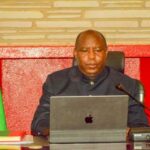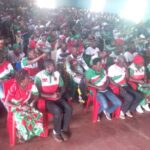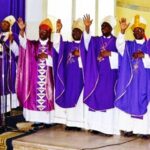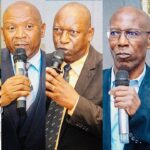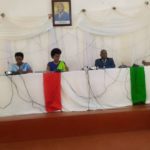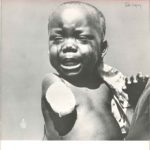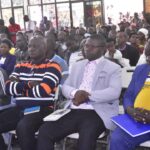 1972 BURUNDI GENOCIDE: 45 years of denial
1972 BURUNDI GENOCIDE: 45 years of denial
On 29th April 1972, started “Burundi’s Crystal night”, a pogrom against Hutus where 300.000 people were massacred by a mono-ethnic army. They were targeting Hutus elements from all walks of life beginning with 700 troops and a total of 190 Hutu officers in its ranks at earlier hours of the ethnic cleansing.

On 28th of April 2017, the Burundian community in Scandinavia commemorated the 45th anniversary of 1972 genocide against Hutus in the premises of the Oslo Holocaust Center. The commemoration was a reminder that in April 1972, Burundi recorded Africa’s first genocide where more than 300 000 people were massacred. The vast majority of them were Hutus. The army carefully exterminated all Hutu elements in its ranks, beginning with 700 troops and a total of 190 Hutu officers were massacred at earlier hours of the ethnic cleansing. The carnage went on in the whole country, killing all educated Hutu, including civil servants, policemen, members of the clergy, teachers, university students and school children, businessmen, artisans, farmers, etc. Recounting what he saw at the time, one Tutsi observer, Boniface Kiraranganya, wrote: “It is the paroxysm of dementia, the most perfect example of what men are capable of doing when their hold on power allows them to do anything they want, when there is no obligation for him to control his destructive instincts”.
The World stood by and easily watched
After what had happened in Burundi, according to Prof. René Lemarchand, the social profile of the victims reflects a planned extermination hardly deniable. Putting in historical perspective the World had experienced the World War II and the Holocaust a decade ago, the United Nations had adopted the Convention on the Prevention and Punishment of the Crime of Genocide on 9th December 1948, which stipulated that “The Contracting Parties confirm that genocide, whether committed in time of peace or in time of war, is a crime under international law which they undertake to prevent and to punish.” A day after on 10th December 1948 in Paris, France, the United Nations had adopted the Universal Declaration of Human Rights, the first global expression of what many people believe to be the rights to which all human beings are inherently entitled and its cornerstone being right to life. Then how could this happen un-noticed and why the International Community didn’t step in to stop it? Undoubtedly, the 1972 Hutu Genocide is a case of state killing that was carefully and sophistically covered up by Western governmental and journalistic sources, blamed instead on the victims and ancient tribal hatreds. Richard Robbins, professor of anthropology at the State University of New York also agrees, saying that we examine cases of purported ethnic conflict we generally find that it involves more than ancient hatred; even the hatreds we find are relatively recent, and constructed by those ethnic entrepreneurs taking advantage of situations rooted deep in colonial domination and fed by neocolonial exploitation.
The USA, its allies and United Nations failed their International obligations
There is evidence from cables sent to State department from US Embassy in Burundi detailing the massacre at the White House level. The Nixon tape transcriptions reveal that top Nixon’s security Advisers were discussing the Burundi genocide with him: “Nixon: I have been hearing about Burundi for a long time—heard about it in the Senate. Bush: Brad Morris is handling that. He is with the U.N.
Kissinger: You would think with all the bleeding hearts in the country. I was reading about this, they have killed every male of every family that has any education at all— grammar school—Hulus… Bush and Rogers: Hutus. Nixon: Wow…why? Kissinger: It’s a governmental policy. It isn’t that the soldiers are running wild. It’s a systematic effort to kill the male members of educated [unintelligible] Nixon: How do they do it? Bush: Shoot them. Kissinger: Go around to the villages and shoot them Bush: Or take a bayonet and kill them” with no action taken. Nixon: I want hard action and second, I want to get that Burundi Ambassador’s ass out of there right now. Kissinger: I’ll send the order today. Nixon: We…I think you will agree Henry; we have really had a double standard on this thing”.
Throughout the whole Burundi genocide episode, the State Department maintained the position that the U.S. government had no leverage in Burundi regardless the President’s call to stop double standards and take hard action. Hardly more enlightening were the comments of the UN Secretary General Kurt Waldheim, who expressed his “fervent hopes that peace, harmony and stability can be brought about successfully and speedily, that Burundi will thereby achieve the goals of social progress, better standards of living and other ideals and principles set forth in the UN Charter”.
The lack of response from the International community and its complicity in front of the tragedy of such magnitude is more difficult to comprehend. Some scholars and experts on Burundi and Great Lakes of Africa suggests that a more important consideration is that many observers, including some well-known journalists and academics, have tended to endorse uncritically the version of events conveyed by the government officials of powerful countries.
Interventions from commemoration speakers
The Keynote speaker, Hon. Robert Krueger, former US representative and Senator from Texas, and former US Ambassador to Burundi since 1964 to 1966, told participants that 8% of the population were killed in 1972. The same army that slaughtered people in 1972 were the same who massacred innocent people during his time as Ambassador in Burundi 94 – 96. He also suggested that what happened in 1972 has correlation with the massacre in 94 – 96 and the situation in Burundi now. He discussed the consequences of the International Community that contributed to deny justice to victims and their families.
Describing what he saw at the time, the former Director of the high school “Ecole Normale de Kiremba” 1965 – 1986, Mr. Henry Stålgren, shared the unspeakable and powerless moments when he witnessed his 127 students and 9 staff members being boarded in the truck to be butchered by the army and paramilitary. With tears in his eyes, Mr. Henry struggled to find words to describe what he experienced.
Burundians have moved forward
Over the years, there are ways the history of Burundian genocides has been narrated world over, passed from generation to generation with many colorful pictures leaving a culturally united country with a divide history. The way Burundian history was told and the way it was perceived changes as the years pass by and the new awareness sink in. As Prof. René Lemarchand rightly points out in one of his books: “The biggest threat to the Great Lakes region of Africa is the ethnization of history, where each group claim to have the monopoly and privilege of holding the truth, and where the story separates the good from the bad ethnic group.”
Burundians must transcend this sad attitude and make facts to be the basis of the truth, so that the shadows of our collective memory are definitely illuminated and truth enlightens the sons and daughters of the same country who, together, must assume their history and work together so that horrors such as those of 1972 never happen again.
The commemoration was one of its kind after four decades of denial, it marked the beginning of a process to expose old lies and reveal truth that will enable Burundians to heal and draw a new picture that will emerge from the realities of their past enlightening a new future.
The highlights from the commemoration can be watched on this video: https://youtu.be/wzPKwaXjy64




